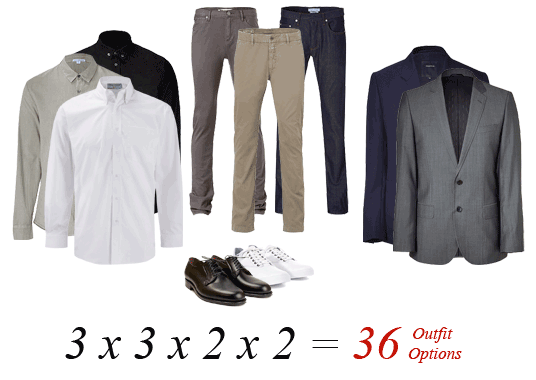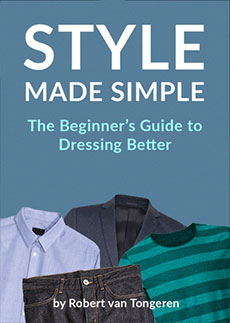How to Build a New Wardrobe on a Budget: Upgrade in 3 Steps

Rich people have it so easy, don’t they?
Not only do they have everything they need, they get to look amazing as well.
When they want a new wardrobe, they just throw a wad of money at whatever catches their eye, never even bothering to look at the freaking price tag.
They’re always dressed to kill, without even thinking. Their personal stylists and shoppers tell them what looks good and what doesn’t. They don’t have a worry in the world.
If only you had their money, their bank accounts, their credit cards. You’d be looking just as good. Better even.
But you don’t.
You’re stuck with a second-rate salary, wondering how to build a new wardrobe on a budget. You can’t spend all your money on clothes. You can only go shopping once in a blue moon, which is already too much of a cost. Spending more would break your bank account.
You want to dress better, but the price tag just seems too high.
But what if it wasn’t?
What if you could upgrade your wardrobe on a super-tight budget?
Note: This article may contain affiliate links. That means if you click a link and purchase something, I earn a small commission, at no additional cost to you. All opinions are my own.
You Can Upgrade Your Wardrobe on a Budget (Without Spending a Fortune)
Back when I decided to build a more stylish wardrobe, I only had a part-time job, so I had very little money to spend. Clothes were already pretty costly, and now I had to start investing in the stylish stuff. I assumed I’d have to go full-on frugal to afford it.
And many men assume the same.
But I was wrong. I didn’t need as much money as I thought. Most of my beliefs on the cost-to-style relationship for clothes turned out false.
Many of you have emailed me that your second-rate salary holds you back from upgrading your wardrobe. Well, today you’ll come to understand a second-rate salary is plenty to do so.
You just need to learn how to shop for a new wardrobe on a budget.
And to do that, we first need to destroy some of your false beliefs.
So let’s get started on that.
False Belief 1: Clothes Shopping is Expensive
In the past, I considered clothes shopping an expensive endeavor. I would spend around $300 every time I went, so I always put it off.
But now I realize it only seemed expensive, because I put it off. I only went about once every six months, which amounts to a lousy $50/m on clothing cost.
What sounds better to you? Spending $300 in one day or spending $50/m for the next six months?
In both cases you spend the same amount, but the latter seems more doable, right?
So instead of shopping sporadically and buying in bulk when you do, go shopping regularly and spread your expenses over time.
False Belief 2: You Need to Buy a Whole New Wardrobe at Once
This belief is false on two fronts:
First, you don’t need as many clothes as you think.
When I built my new wardrobe, I discovered I could combine the various pieces in different ways, giving me plenty of outfits. Invest in versatility, and you can do the same.

Second, you don’t need to do a complete wardrobe overhaul at once.
As I built my wardrobe, I just wore my new clothes with the ones I already owned.
My old clothes didn’t fit the new look I was going for, and they certainly didn’t fit my body perfectly. So as I built the wardrobe I wanted, I got rid of them, but I was in no hurry.
Remember your style journey isn’t a race.
You can mix the old and the new until you have enough new to get rid of the old.
False Belief 3: You Need to Invest in Expensive Clothes
Many men assume they need to buy expensive goods to improve their style.
Who can blame them? Just open a GQ magazine, and look at the prices of the items they promote. They’re pretty damn steep.
But buying expensive clothes won’t fix your style. Learning how to put a good outfit together will.
You could buy a $700 blazer from Versace or a $100 blazer from Zara, but the only thing that matters is how it looks on you.
Maybe the Versace blazer is somewhat higher quality, and maybe it will last somewhat longer — honestly, I haven’t tested it, so I can’t say — but the biggest part of the price difference comes from the brand. And nobody, except for a few fashion-nuts, will care or even notice. You don’t need to go for expensive brands to look good.
When you build your new wardrobe, just stick to affordable clothes, especially when you’re in the early stages of your style education. Mistakes you make will hurt a lot less when you haven’t sacrificed half a month’s paycheck on them.
You’re better off learning the ropes with clothes you can actually afford. You can look fine in cheaper clothes
False Belief 4: Cheap Clothes Can’t Be Stylish

You think cheap clothes can’t be stylish, because you assume they’d be more expensive if they were — which seems like a logical conclusion.
I held this belief once. And I cry myself to sleep sometimes over all the money I’ve blown on overpriced jeans.
Assuming stores would charge more for their most stylish clothes makes sense, but style doesn’t decide the price. Consumers decide the price.
Clothes that stand out are more expensive, because they make you go “Ooh! Cool! Me want one!”
Men are more willing to spend on them.
Supporting pieces are usually cheaper, because they don’t invoke much of a reaction on their own.
Who’s gonna spend $30 on a plain white tee, $70 on a plain grey sweater or $200 on a pair of plain blue jeans?
Nobody.
Most men see supporting pieces as boring, because we have a blind spot for them.
When we see a magazine ad, the statement pieces catch our attention. We don’t even see the white shirt, the camel chinos, or the grey sweater. We only see the bold red, polka-dotted tie. (And that’s the point.)
And you don’t need that many statement pieces anyway, so the majority of your new wardrobe should be relatively inexpensive.
Supporting pieces are the building blocks of a great outfit, so you’ll be happy to hear stores practically try to give them away.
Not only are they incredibly cheap, stores often offer buy-in-bulk deals.
- “2 for the price of 1!”
- “Buy 3 and get 30% off!”
- “Buy 2 and the 3rd is free!”
Just don’t get too easily persuaded by these deals. You still have to make sure everything fits, because spending so much as $1 on a T-shirt that fits poorly is still a waste.
And don’t use this article as an excuse to skimp. Use it to resist overspending.
How to Build a Wardrobe on a Budget: 3 Steps to Smarter Shopping
Okay, enough belief-shattering for today. You want to know how to build a new wardrobe already.
So let’s turn you into a super-smart shopping machine, yeah?
With the following plan, you’ll discover the best stores for you, protect yourself from overspending and focus on the clothes you need without getting sidetracked.
Step 1: Unearth Your Best Stores
The first step to upgrading your wardrobe is determining which men’s clothing stores sell the clothes that fit your body closest.
You have to identify the stores selling your best-fitting shirts, the stores selling your best-fitting pants, the stores selling your best-fitting blazers, etc. These may be three entirely different stores.
Take a day for each type of garment, and visit every — and I mean EVERY — store in your local shopping center.
The rules:
- Focus on one item at a time. You won’t find enough time to visit every store, and you won’t memorize all the proper fits of all the different types of clothes at once. Focusing on one item at a time will be less overwhelming.
- Forget past prejudices. Try out the stores you assume too crappy or too expensive. Maybe they are, or maybe you find out they’re not as bad as you think.
- Don’t stop when you’ve found a good store. You may still find better ones.
- Leave your wallet at home. Bringing your wallet will tempt you to buy something, which could prompt you to drop your search.
You’re not shopping. You’re evaluating. You’re finding stores for future reference.
You want to end up with a short list of the best stores for you, so when you start the shopping process, you’ll know exactly which stores to visit, and which to skip. You’ll be done in a jiffy.
Step 2: Set a Monthly Style Budget

Instead of blowing a big wad of money every so often, you will spread your spending over time.
Every month you receive your paycheck, you will withdraw a set amount and put it in an envelope marked “My Awesome Style Budget”.
The rules:
- Withdraw your budget as soon as you’re able. Putting it off will make you forget.
- Go shopping on your first off-day after you receive your paycheck. Postponing your clothes-shopping will tempt you to take money from your envelope to spend on other things.
- Take only the money in your envelope. Leave your wallet and credit cards at home. You’ll keep yourself from overspending and from wasting money on impulse buys.
When an item costs more than your budget allows, simply save the money in your envelope for a month, and buy it the next one.
Building some early momentum is important, so I suggest you set your starters budget around $100/m. After you’ve built a solid foundation, you can decrease the budget a bit, if you want.
Step 3: Create a Shopping Plan
Before you go out, make a list of the clothes you need. Start with foundational items, like the ones in the Restart Capsule., because they’ll be easy to match.
Find out the average price of each item on your list. You don’t have to be ultra-specific as you’ll only use these as guidelines. Try websites and online stores.
When you’re done, you’re ready to plan your shopping.
Simply divide your list in segments, making sure each segment’s combined cost matches your budget, and every month you go out and buy one segment.
Let me give you an example:
Say you set your budget at $100.You located some good stores and the average prices for their items are as follows:
- Shirts – $30
- T-shirts – $10
- Jeans – $60
- Pants – $40
- Blazers – $120
You could plan your shopping as such:
- Month 1: Buy 4 T-shirts, 2 Shirts
- Month 2: Buy 1 Pair of Jeans and 1 Pair of Pants
- Month 3: Buy 2 more shirts, save the rest for next month.
- Month 4: Buy 1 Blazer
Now you have your plan, and you’re ready to start shopping.
Oh, and before I forget… If you want not only a great shopping plan, but also the confidence that each piece you buy will make a great addition to your new wardrobe, Style Made Simple: The Beginner’s Guide to Dressing Better should be on the top of your shopping list.
And in case you think your money is better spent on your wardrobe itself; Style Made Simple will show you how to dress well on a budget and avoid unnecessary mistakes, and thus you’ll save money in the process.
You should make the investment, before you get started.
Building a New Wardrobe on a Budget Will Be a Piece of Cake
As men, we operate under a set of beliefs.
Beliefs can empower us, but they can also limit our progress. They tell us we can’t do something, and then our minds develop evidence to back it up.
I’ve done my best to shatter your false beliefs, but the only way to truly erase them from your mind is to take action and see for yourself.
You have to replace your mind’s so-called evidence with your own, see-it-with-your-own-eyes experience.
By shopping smartly, you’ll quickly discover that the cost of upgrading your wardrobe is far less than you imagined.
Now you know how to build a wardrobe on a budget. You have plenty of money to get started.
Don’t worry about expensive clothes at this point. You don’t need a Porsche to learn how to drive, and you don’t need fancy designer clothes to learn how to dress yourself.
Learn to create awesome outfits with affordable clothes before you even consider the high-priced items.
And once you’re ready to spend big, you’ll already have a killer new wardrobe at your disposal.
You’ll be rocking stylish clothes before you know it, man.
Did You Find That Useful? Then Check This Out…

I wrote a men’s style guide that simplifies the art of dressing well, focuses on what matters, and takes you through it one step at a time. Enter your e-mail below and you’ll receive three free chapters, which will show you:
